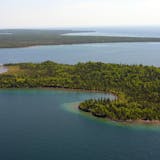The biggest airplane in Northwest Airlines' fleet -- a Boeing 747-400 -- will be the first aircraft to be painted in the red-white-and-blue color scheme of Delta Air Lines, which acquired Northwest last week.
Getting the right airplane on the right route is one of the bedrock elements of the Delta-Northwest merger, which will create the world's largest airline.
Delta executives did not disclose the routes that will be affected by the fleet changes. But Glen Hauenstein, a Delta executive vice president, said the ability to move planes to where they are needed is the "key driver" in reaching the merger's financial goals. Delta executives have said they expect the combination will yield about $1 billion in annual cost savings and $1 billion in new revenue.
"Northwest wide-body planes are probably too big for the markets they serve," said Hauenstein. The 747, which seats 403 passengers, is one of Northwest's twin-aisle or "wide-body planes" and it is expected to be flown on some of Delta's routes next year. One possibility is operating 747s on an Atlanta-Tokyo route. Delta's largest hub is in Atlanta, while Northwest has a major hub in Tokyo.
"It will take some time to migrate the brand," Delta CEO Richard Anderson said in an interview. But he added that Northwest customers will begin to see changes in the coming months, such as the addition of blue leather seats on Northwest planes and the appearance of Delta's food offerings on Northwest flights.
But Anderson and his management team are particularly intent on achieving the financial benefits that they believe will be produced by blending the fleets of Delta and Northwest. Hauenstein said that Delta's largely Boeing fleet is heavily weighted toward large single-aisle planes and small twin-aisle planes. In contrast, he said, Northwest's Boeing and Airbus fleet is dominated by small single-aisle planes and big twin-aisle jets. When you merge the fleets you get "planes as small as 100 seats and as big as 400 seats and pretty much everything in between," he said.
For some time, Hauenstein said, the airline industry viewed fleet simplification as a smart business choice, because having a small number of plane types can reduce maintenance and pilot training costs.
But he argues that standardization comes at a high price.


